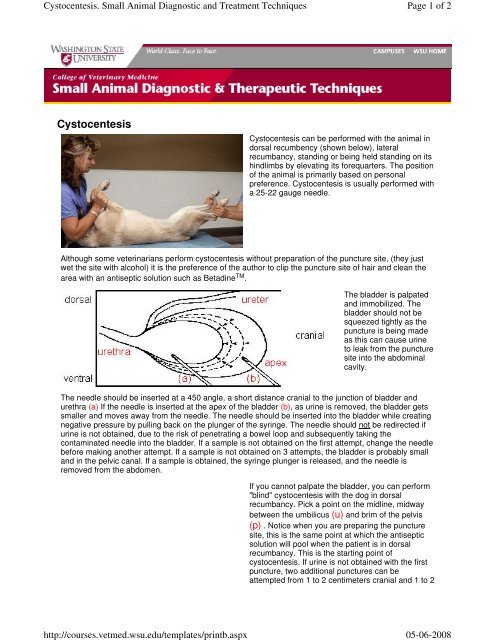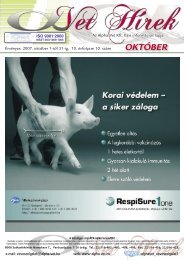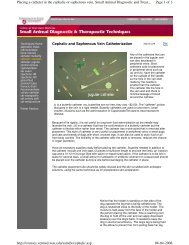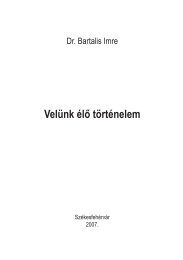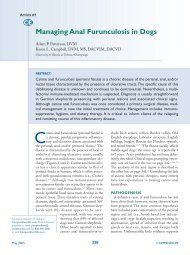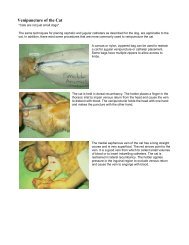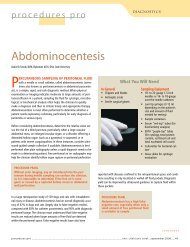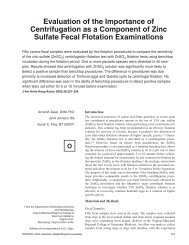Cystocentesis - Hungarovet
Cystocentesis - Hungarovet
Cystocentesis - Hungarovet
You also want an ePaper? Increase the reach of your titles
YUMPU automatically turns print PDFs into web optimized ePapers that Google loves.
<strong>Cystocentesis</strong>. Small Animal Diagnostic and Treatment Techniques<br />
http://courses.vetmed.wsu.edu/templates/printb.aspx<br />
Page 1 of 2<br />
05-06-2008<br />
<strong>Cystocentesis</strong><br />
<strong>Cystocentesis</strong> can be performed with the animal in<br />
dorsal recumbency (shown below), lateral<br />
recumbancy, standing or being held standing on its<br />
hindlimbs by elevating its forequarters. The position<br />
of the animal is primarily based on personal<br />
preference. <strong>Cystocentesis</strong> is usually performed with<br />
a 25-22 gauge needle.<br />
Although some veterinarians perform cystocentesis without preparation of the puncture site, (they just<br />
wet the site with alcohol) it is the preference of the author to clip the puncture site of hair and clean the<br />
area with an antiseptic solution such as Betadine TM .<br />
The bladder is palpated<br />
and immobilized. The<br />
bladder should not be<br />
squeezed tightly as the<br />
puncture is being made<br />
as this can cause urine<br />
to leak from the puncture<br />
site into the abdominal<br />
cavity.<br />
The needle should be inserted at a 450 angle, a short distance cranial to the junction of bladder and<br />
urethra (a) If the needle is inserted at the apex of the bladder (b), as urine is removed, the bladder gets<br />
smaller and moves away from the needle. The needle should be inserted into the bladder while creating<br />
negative pressure by pulling back on the plunger of the syringe. The needle should not be redirected if<br />
urine is not obtained, due to the risk of penetrating a bowel loop and subsequently taking the<br />
contaminated needle into the bladder. If a sample is not obtained on the first attempt, change the needle<br />
before making another attempt. If a sample is not obtained on 3 attempts, the bladder is probably small<br />
and in the pelvic canal. If a sample is obtained, the syringe plunger is released, and the needle is<br />
removed from the abdomen.<br />
If you cannot palpate the bladder, you can perform<br />
"blind" cystocentesis with the dog in dorsal<br />
recumbancy. Pick a point on the midline, midway<br />
between the umbilicus (u) and brim of the pelvis<br />
(p) . Notice when you are preparing the puncture<br />
site, this is the same point at which the antiseptic<br />
solution will pool when the patient is in dorsal<br />
recumbancy. This is the starting point of<br />
cystocentesis. If urine is not obtained with the first<br />
puncture, two additional punctures can be<br />
attempted from 1 to 2 centimeters cranial and 1 to 2
<strong>Cystocentesis</strong>. Small Animal Diagnostic and Treatment Techniques<br />
http://courses.vetmed.wsu.edu/templates/printb.aspx<br />
Page 2 of 2<br />
05-06-2008<br />
centimeters caudal to the initial puncture site. If<br />
urine is not obtained on the first attempt, change<br />
the needle before making another attempt. If a<br />
sample is not obtained on 3 attempts, the bladder is<br />
probably small and in the pelvic canal. Try again<br />
later to collect a sample.<br />
<strong>Cystocentesis</strong> can be performed on the midline in male dogs by retracting the penis and prepuce off the<br />
midline.<br />
return to main menu<br />
Revised June 19, 2004 | http://courses.vetmed.wsu.edu/samdx/cysto.asp


